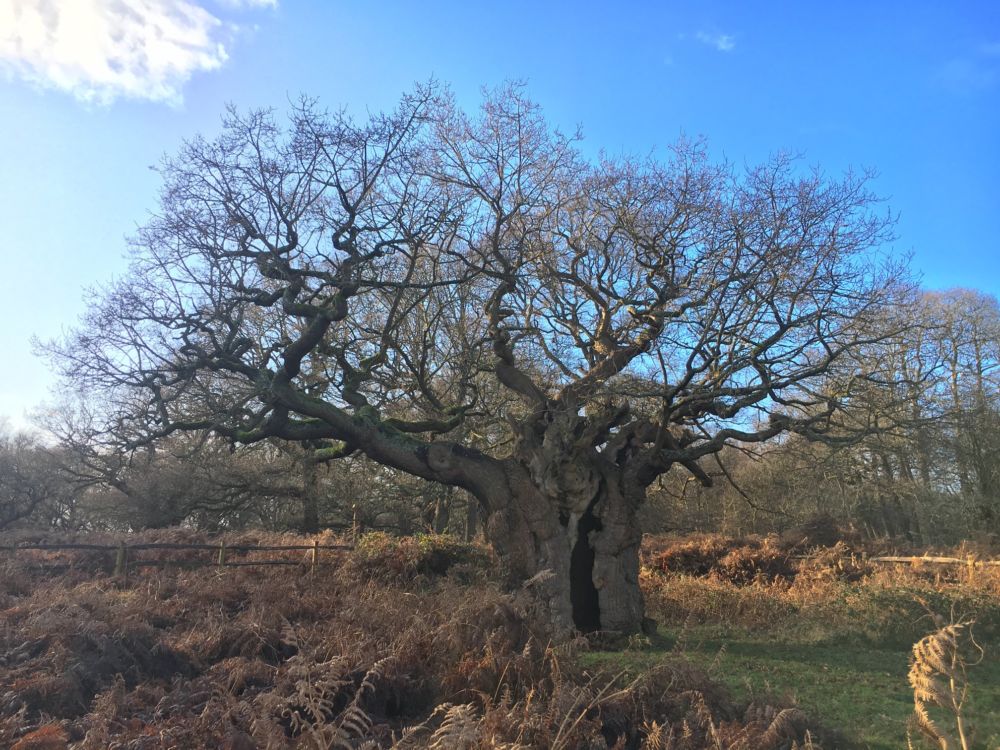The Royal Oak, photo by Richard Gray
Friends launch ‘Year of the Tree’ with iconic Royal Oak artwork
At an event in Pembroke Lodge on 6th November, Friends of Richmond Park Patron Baroness Susan Kramer launched Year of the Tree (YOTT), the Friends’ year-long conservation campaign during 2020 to help protect and enhance the Park’s 130,000+ trees and raise visitors’ understanding and appreciation of the trees and their importance in the Park’s ecology.
(Click here to watch our Year of the Tree video featuring Sir David Attenborough)
Baroness Kramer also unveiled a wonderful picture of the iconic, ancient Royal Oak tree in Richmond Park, a stunning new artwork by acclaimed artist Mark Frith commissioned by the Friends as the emblem for Year of the Tree. 100 limited edition prints of the artwork were produced, each signed and numbered by the artist. The prints were offered for sale to the public and all have now been sold. Proceeds of the sales will go to tree conservation projects in the Park. Smaller, 35cm x 28cm prints have also been produced, and are on sale at the Visitor Centre in Richmond Park.
Just seven species make up 90% of the Park’s trees: Oak 45% (English, Turkey, Northern Red, Sessile and the evergreen Holm varieties), Beech 20%, and 20% across five species, Hawthorn, Blackthorn, Birch, Hornbeam and sweet and horse chestnut. The remaining 10% are a variety of indigenous and exotic species including Willows, Alders, Cedars and Sugar Maples.
The Park’s trees are essential, the largely unsung heroes of its rich biodiversity. They:
- absorb CO², ammonia, ozone, NOx and SO² (nitrogen oxides and sulphur dioxide engine emissions) whilst producing oxygen.
- provide habitats for thousands of wildlife species; bats, birds and invertebrates
- conserve energy and water
- prevent soil erosion
- help to reduce the temperature and help combat climate change
As Assistant Park Manager Adam Curtis puts it in the Friends’ Guide book:
“The veteran oaks, the tall boundary beeches and the younger plantations of mixed species create unique atmospheres supporting a vast array of wildlife. They define the landscape’s character, filtering out the presence of London. They shelter our long country walks, creating intrigue and intimacy, enticing us deep into contemplation.”
There are around 1,400 veteran trees (the ‘Crown Jewels’ of Park trees) up to 800 years old in the Park, including the Royal Oak, and they are high on our list of conservation projects for the YOTT campaign. In addition, there are many activities and initiatives for members and Park visitors to engage with. The Royal Oak artwork we hope will capture people’s imagination on the beauty and importance of the Park’s trees and sales of prints and merchandise will help fund investment in the Park’s conservation.
As part of YOTT, we’re launching a series of special tree walk booklets which we hope will provide huge enjoyment as well as raised interest in trees. The walks innovator, Christopher Hedley, will lead some of these walks during the year and there will be a programme of walks and talks focusing on trees.
A number of children’s and family events – including storytelling – are being organised to commence in the spring and a tree photography competition will be announced soon. Those who buy and love the Friends calendar or who look at our Facebook page will know that there are some wonderful Park photographers but tree photography is a real skill which we hope many photographers will want to engage with
From existing Friends’ funds, sales through the visitor information centre and sales of the The Royal Oak prints and merchandise, we plan to contribute up to £100,000 to the following conservation projects during 2020:
- Fencing for up to 40 veteran oaks providing a protective cordon around the trees, preventing compaction and discouraging barbecuing and climbing. Veteran oaks are especially important to a wide range of wildlife from hundreds of insect species, nesting birds, roosting bats, lichens, and even grass snakes and great crested newts.
- Planting of future veterans: creating future veteran oaks and sweet chestnuts by planting and pollarding.
- Hawthorn and blackthorn protection and planting; thorns are important to wildlife as a source of nectar, berries for birds and hosting many invertebrates, but they need protection from grazing deer.
- Planting of sallow (grey willow); foliage is eaten by a number of moth caterpillars, as well as the rare purple emperor butterfly; caterpillars are foraged by birds; catkins provide important early source of pollen and nectar for bees and other insects
- Planting of fruit trees (e.g. crab apple, wild pear, damson); blossom provides nectar for bees and other pollinators; fruits are a food source for deer, birds and invertebrates
- Modification and upgrading of the current Park nursery to enable growing of young trees and seedlings.
The projects (and others) will be introduced over the period to the end of 2020, working closely with The Royal Parks and Richmond Park Manager Simon Richards and his team.
We’re delighted that Sir David Attenborough has agreed to be Patron of Year of the Tree. He told us:
“I think the Year of the Tree is a really splendid idea. An exciting change of focus for the Friends that will, I am sure, be full of interest and a revelation for all concerned. I am flattered that you should suggest that once again I become Patron”.


